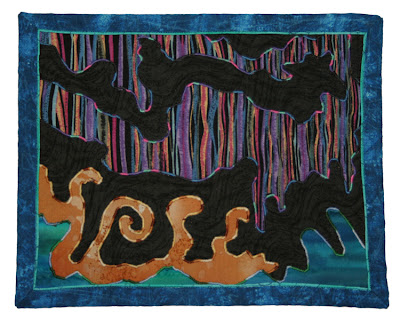A few months ago the search for the perfect machine binding began. Is there such a thing? If so, I haven't found it yet. I've tried several types, the quilts below are the best ones to date. Both are pretty good; but not quite good enough. Is it possible that my standards are too high? Maybe I just haven't done enough of either to be really good. I think I need to try a few more before I give up and sew the bindings on by hand.
 The quilt above doesn't actually have a separate binding. The back of the fabric was brought to the front, folded and mitered at the corners and sewn on with a straight stitch. It was pretty fast but it doesn't give the finished appearance I want.
The quilt above doesn't actually have a separate binding. The back of the fabric was brought to the front, folded and mitered at the corners and sewn on with a straight stitch. It was pretty fast but it doesn't give the finished appearance I want. This binding technique is the one that Ricky Timms uses on his quilts. I watched his Grande Finale video and decided to give it a try. I watched it two times, took notes, purchased a special foot, Pearle cotton and set to work. There is definitely a learning curve on this one. Mitering the corners are the hardest part.
This binding technique is the one that Ricky Timms uses on his quilts. I watched his Grande Finale video and decided to give it a try. I watched it two times, took notes, purchased a special foot, Pearle cotton and set to work. There is definitely a learning curve on this one. Mitering the corners are the hardest part.I like the two colors on the binding. I think it adds a wonderful spark to the edge. Hopefully, the next one will be much quicker!





1 comment :
Maybe you could incorporate some decorative stitching and make it look like you really meant it to be by machine? (a design decision vs. hand/machine decision)
Post a Comment